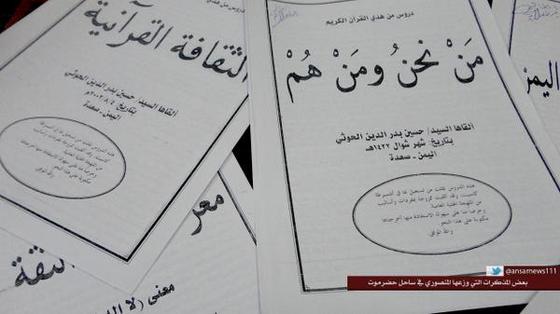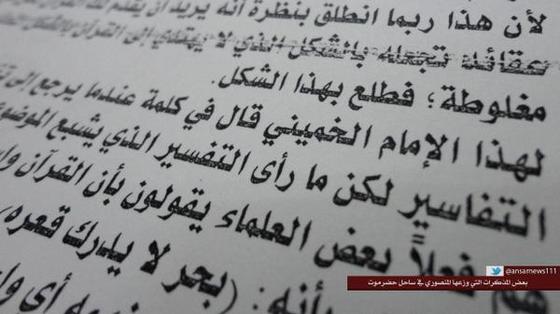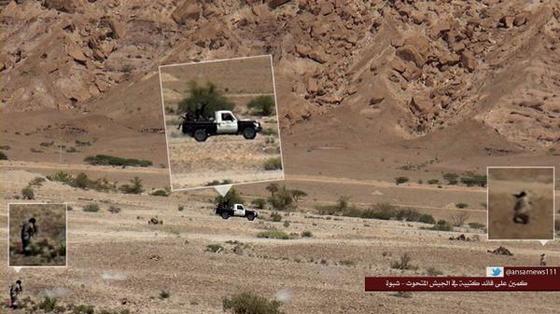In a series of tweets posted by an al Qaeda in the Arabian Peninsula (AQAP) affiliated account on Oct. 15, the terrorist group claimed credit for four separate attacks aimed at a variety of targets in Hadramout, Shabwa, and Abyan provinces in Yemen. These attacks come as AQAP has been stepping up its terrorist activity in conjunction with the advance of Shi’ite Houthi militants throughout the country. On Oct. 14, Houthi fighters consolidated their control over the city of Hodeidah on the Red Sea coast as well as on the key central city of Dhamar.
The first AQAP attack was a drive-by assassination attempt targeting Omar Faraj al Mansouri, whom the jihadist spokesman described as a Houthi leader, in the coastal city of al Shihr in eastern Hadramout province on Oct. 12. Local media reports stated that “anonymous militants” on a motorbike fired at al Mansouri in the vacinity of the Shiqaq neighborhood of al Shihr. Eye witnesses claimed that al Mansouri was in a moving vehicle that was pursued by the assailants on the motorbike and that he was seriously injured in the head by gunfire. While some local sources claimed that al Mansouri was an “ordinary citizen” with no political connections, others suggested that he was linked to the Houthis.
In a statement claiming credit for the attack, AQAP said that al Mansouri was severely injured by the assassination attempt and initially taken to the main public hospital in al Shihr. The statement continued by noting that al Mansouri’s condition deteriorated significantly, prompting his transfer to the Ibn Sinaa’ Hospital in the provincial capital of al Mukallah. The statement also claimed that al Mansouri “has been active for a time in the Hadramout coast calling for the spreading and embracing of the Houthi rafidi [Shi’ite] religion.”
AQAP accuses al Mansouri of holding overt and covert meetings to further the Houthi cause, distributing Houthi propaganda among “simple Sunnis,” and intending to spread “the Houthi religion” in all of the Hadramout coast.” The AQAP statement concludes by noting that al Mansouri was part of the Houthi delegation at the National Dialogue Conference that signed the Peace and National Partnership Agreement. AQAP describes this agreement as having “given the reins of power in Sana’a to the rafidi [Shi’ite] Houthis under American-Gulf sponsorship.”
AQAP carried out an additional assasination attempt on Oct. 14, targeting a commander of the Popular Committees (PCs) in the city of Gol al Raydah in Shabwa province. The Popular Committees are local armed resistance groups which played a large role alongside the military in pushing out al Qaeda and its local affiliate Ansar al Shariah from Abyan province in 2011. A local official told the Arabic media that “the commander in the Popular Committees, Ali Saleh Baqatmi was injured…with grave wounds as a result of the explosion of an improvised explosive device [IED] that targeted his vehicle in the Mayfa’a district of Shabwa province.” The official also noted that Baqatmi was taken to Ibn Sinaa’ Hospital in al Mukallah for treatment.
In a statement claiming credit for the assassination attempt, AQAP stated: “We have previously repeatedly warned via more than one statement and have emphasized that anyone who takes part in the Popular Committees and participates in fighting Sunnis in Shabwa will be a legitimate target for us no matter who it is. Now we are executing what we have vowed, and we vow more [such attacks] in the future, Allah willing.”
AQAP claimed credit for yet another attack that took place on Oct. 14 in Shabwa province, this time targeting the Yemeni military. In a statement released the following day, AQAP stated that mujahideen has previously staged an ambush along the road linking the Khamr region to Shabwa’s capital, Ataq. A military vehicle carrying Mohammad al Shabahi al Maysari, the commander of a Yemeni military brigade stationed in Shabwa, passed by the ambush location at 12:30 pm, according to the statement. AQAP fighters immediately opened fire on the vehicle, killing al Maysari and wounding four soldiers who were accompanying him.
The final Oct. 14 attack that AQAP has claimed credit for was another operation targeting Yemeni soldiers. AQAP fighters ambushed military vehicles in the Dayqa valley in the Mahfad region of Abyan, long known to be a stronghold of the terrorist group. The statement claimed that “a group of soldiers” were killed and wounded, yet noted that “it is difficult to determine their number definitely.”
The following photos accompanied the aforementioned AQAP statements:
Houthi-related documents that AQAP accused al Mansouri of disseminating in Hadramout. These documents were penned by Hussein Badr al Din al Houthi, the founder of the Houthi movement whose family name has come to define the movement.
An excerpt from Houthi propaganda that AQAP accuses al Mansouri of propagating. This section of the text refers to Imam Khomeini’s Qur’anic interpretations.
This picture shows the AQAP ambush that killed Yemeni military commander Mohammad al Shabahi al Maysari.
Are you a dedicated reader of FDD's Long War Journal? Has our research benefitted you or your team over the years? Support our independent reporting and analysis today by considering a one-time or monthly donation. Thanks for reading! You can make a tax-deductible donation here.










